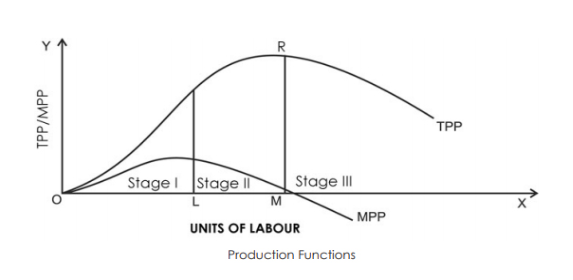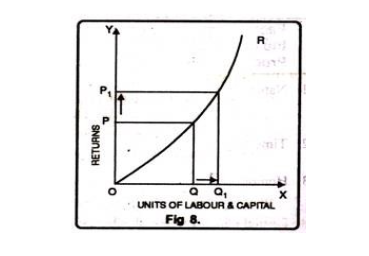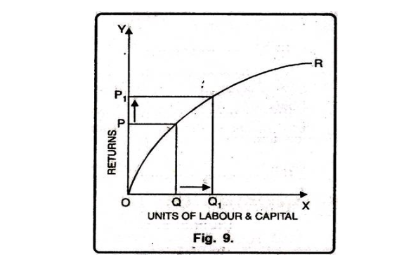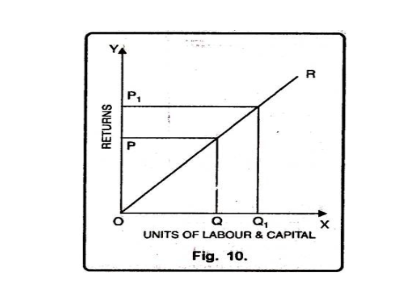Table of Contents
The Laws of Production are essential principles that illustrate the connection between inputs and outputs in the manufacturing of goods and services. These laws provide important insights into how resources are allocated, how efficiently production can be conducted, and the relationships among different production factors. The Law of Variable Proportion and the Law of Returns to Scale are particularly significant, as they play a critical role in shaping production processes and informing economic decisions. In this article, we will examine these production laws in detail.
Law of Variable Proportion and Law of Return to Scale Overview
In economics, the notion of cost and producer equilibrium is managed by the Law of Production. It’s a critical part of economics since it assists a company in deciding the quantum of produce that will affect in the utmost gains. It also specifies the company’s multiple variable and fixed costs. The two laws of product are the Law of return to scale and the Law of variable proportion. The rules of production define the technologically possible methodologies of building up produce. The produce can be grown in a variety of ways.
What are the Laws of Production?
The production laws describe the technically possible ways to increase the degree of output. Production can be increased in many ways. Production can be boosted by revising all means of production. This is only possible in the long term. Hence, the Law of Return to Scale refers to the long-term analysis of production.
In the short run, the production can be boosted by utilising further variable factors, while holding capital (and conceivably other factors as well) constant. The marginal product of variable factors will ultimately lower as further and further of these factors are combined with other constant factors. The expansion of produce with (at least) constant factor is described by the law of (ultimately) diminishing returns to variable factor, often called the law of variable proportions.
The laws of production in economics are related to the notions of cost and equilibrium of directors. It’s an important aspect of economics as it helps the company determine the degree of production that leads to maximum profit. It also defines the many fixed and variable costs of the business.
Types of Laws of Production
The Laws of Production consist of two main principles: the Law of Variable Proportion, also known as the Law of Diminishing Marginal Returns, which explains how adding more of a variable input can lead to diminishing additional output; and the Law of Return to Scale, which examines how increasing all inputs in equal proportions affects overall output, with three possible outcomes – increasing returns, constant returns, or decreasing returns to scale. Together, these laws provide essential insights into the efficiency and behaviour of production processes in different economic contexts.

Law of Variable Proportion
It states that when the volume of one factor of production is raised while keeping all other factors constant, it results in the decline of the marginal product of that factor. The law of variable proportion is also understood as the Law of Proportionality. When the variable factor becomes more, it can result in a negative value of the marginal product.
The law of variable proportion can be concluded as “When the variable factor is raised while keeping all other factors constant, the total product will increase originally at a higher rate, it’ll be increasing at a lower rate and ultimately there will be a decline in the rate of the product.”
Assumptions of the Law of Variable Proportion
The law of variable proportion holds good under certain circumstances, which will be explained in the lines below.
- A constant state of Technology: It’s assumed that the state of technology will be constant and with advancements in the technology, the production will upgrade.
- Variable Factor Proportions: Another assumption of the Law of Variable Proportion is that factors of production are variable. The law isn’t valid, if factors of production are fixed.
- Homogeneous factor units: This assumes that all the units manufactured are identical in quality, volume and price. In other words, the units or goods are homogeneous in nature.
- Short Run: This assumes that this law is appropriate for those systems that are operating for a short term, where it isn’t possible to alter all factor
Stages of the law of Variable Proportion
There are three stages of the law of variable proportion which are detailed below.
First Stage – Increasing Return to a Factor
In the initial stage, every additional variable factor adds further and further to the total output. It means TP increases at a vast rate and MP of each variable factor rises. Better utilization of fixed factors and increases in the effectiveness of a variable factor due to specialization are the significant factors accountable for higher returns.
The increasing returns to a factor stage have been shown in the given illustration between O to L. It implies. TP increases at an increasing rate and MP rises till it reaches its maximum point’ L’. which marks the end of the first phase.
Second Stage – Diminishing Return to a Factor
In the second phase, incorporating each additional variable input leads to a progressively smaller increment in output. This implies that the Total Product (TP) starts to increase at a slower pace, and the Marginal Product (MP) of the variable input declines as the input quantity grows. The primary reason for this diminishing returns phenomenon is the disruption of the optimal balance between fixed and variable inputs.
This second stage concludes at the juncture labelled ‘M’ where MP becomes zero while TP reaches its peak at point ‘R.’ This second stage is of significant importance as rational producers naturally strive to operate within it. This is because TP attains its highest value here, and the MP associated with each variable input remains positive.
Third Phase – Negative Return to a Factor
During the third phase, the incorporation of extra variable inputs leads to a reduction in Total Product (TP). Moreover, the Marginal Product (MP) turns negative at this point. Consequently, this stage is termed as experiencing negative returns to a factor. The fundamental reason for this phase lies in the insufficient coordination between the variable and fixed inputs.
The third stage commences right after point ‘M’ on the MPP curve and extends to a point on the TPP curve. The Marginal Product for each variable input remains negative throughout these three stages. Consequently, no rational firm would intentionally opt to function within this phase.

Law of return to scale
As stated by Koutsoyiannis, the term “returns to scale” pertains to alterations in output when all factors undergo simultaneous proportional changes.
According to Leibhafsky, “returns to scale” encompasses the overall output’s behaviour as all inputs are adjusted simultaneously, representing a concept applicable in the long run.
Three types of Return to Scale
The three stages are explained below:
Increasing Returns to Scale or Diminishing Costs
- Increasing returns to scale, also known as diminishing costs, occur when boosting all production factors results in a greater-than-proportional surge in output.
- For instance, if inputs are doubled, the output grows more than twice as fast.
- This phenomenon, influenced by factors like division of labour and external economies of scale, can be visualized using Figure 8.

Illustrated in Figure 8, the X-axis (OX) denotes amplified labour and capital, while the Y-axis (OY) signifies heightened output. Upon elevating labour and capital from point Q to Q1, the output surges from point P to P1, surpassing the increment in labour and capital factors.
Diminishing Returns to Scale
- Diminishing returns to scale, or rising costs, materialize when a consistent increase in all production factors leads to a proportionally smaller expansion in output.
- In essence, doubling inputs doesn’t lead to a doubling of output.
- This trend arises due to internal and external diseconomies outweighing economies. Figure 9 illustrates this pattern.

The X-axis (OX) symbolizes labour and capital quantities, while the Y-axis (OY) represents output. As factors of production surge from point Q to Q1 (higher quantity), the corresponding output increase from point P to P1 is relatively smaller. The outcome is that the increase in factors of production is more substantial compared to the increment in production, thus underscoring the presence of diminishing returns to scale.
Constant Returns to Scale
- Constant returns to scale, or constant costs, emerge when output scales up in direct proportion to the enlargement of production factors.
- This equilibrium arises when economies of scale balance out diseconomies, typically occurring after a certain production threshold.

As showcased in Figure 10. This graphical representation depicts that an increase in labor and capital corresponds precisely to an equivalent increase in output, resulting in constant returns to scale.
Conclusion
In conclusion, these laws collectively form the bedrock upon which sound production strategies and economic policies are built. They guide producers and policymakers in making informed choices that optimize output, minimize costs, and foster sustainable growth in economies.




 UGC NET Study Notes for Paper 1, Downloa...
UGC NET Study Notes for Paper 1, Downloa...
 GSET Teaching Aptitude Questions and Ans...
GSET Teaching Aptitude Questions and Ans...
 समुद्र का पर्य�...
समुद्र का पर्य�...












